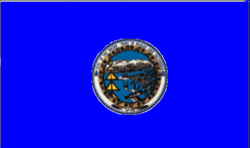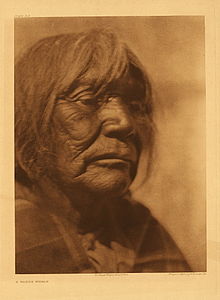Washoe people
This article needs additional citations for verification. (August 2012) |
This article includes a list of general references, but it lacks sufficient corresponding inline citations. (August 2012) |
 | |
| Regions with significant populations | |
|---|---|
( | |
| Languages | |
| English, Washo | |
| Religion | |
| traditional tribal religion[citation needed] | |
| Related ethnic groups | |
| None |
The Washoe are a Great Basin tribe of Native Americans, living in California and Nevada. The name "Washoe" is derived from the autonym waashiw (wa·šiw) meaning "people from here" in the Washo language (transliterated in older literature as Wa She Shu).
Territory
Washoe people have lived in the Great Basin for at least the last 6000 years.[1] Prior to contact with Europeans, the territory of the Washoe people was roughly bounded by the southern shore of Honey Lake in the north, the west fork of the Walker River in the south, the Sierra Nevada crest in the west, and the first range east of the Sierra Nevada in the east. The Washoe would generally spend the summer in the Sierra Nevada, the fall in the ranges to the east, and the winter and spring in the valleys between them.
History

Washoe people are the only Great Basin tribe whose language is not Numic, so they are believed to have inhabited the region before neighboring tribes. The Kings Beach Complex that emerged around 500 CE around Lake Tahoe and the northern Sierra Nevadas are regarded as early Washoe culture. The Martis complex may have overlapped with the Kings Beach culture, and Martis pit houses gave way to conical bark slab houses of historic Washoe culture.[2]
The Washoe people and the neighboring Northern Paiute people were culturally and linguistically very different, and they sometimes came into conflict. The Washoe were confined to the area south of Carson City, and they were deprived from owning horses.[3]
Washoe people may have made contact with Spanish explorers in the early 19th century, but the Washoe did not sustain contact with people of European culture until the 1848 California Gold Rush.[1] Washoe resistance to incursions on their lands proved futile, and the last armed conflict with the Washoes and non-Indians was the "Potato War" of 1857, when starving Washoes were killed for gathering potatoes from a European-American farm near Honey Lake in California.[4]
Loss of the valley hunting grounds to farms and the Piñon pine groves to feed Virginia City's demand for lumber and charcoal drove most Washoe to dependency on jobs in white ranches, farms and cities. The areas where they settled became known as Indian colonies.
Culture

Piñon pine nuts gathered in the fall provided much of the food eaten in the winter. Roots, seeds, berries and game provided much of the food eaten in the rest of the year.[5]
The Pine Nut Dance and girls' puberty rites remain very important ceremonies.[6]
Language
The Washoe language is tentatively regarded as part of the Hokan language family;[7] however, it is also considered to be a language isolate.[3]
Washoe tribes
Under the Indian Reorganization Act of 1934, the colonies in the Carson Valley area of Nevada and California gained federal recognition as the Washoe Tribe of Nevada and California. The colony at Reno, Nevada, which also had a substantial Paiute and Shoshoni population, gained separate recognition as the Reno-Sparks Indian Colony. There is evidence that some Washoe settled into the southwest region of Montana. The Susanville Rancheria includes Washoe members, as well as Northern Paiute, Northeastern Maidu, Achomawi and Atsugewi members.[9]
Notes
- ^ a b c Pritzker, 246
- ^ D'Azevedo, 466
- ^ a b "Washoe Indian Tribe History." Access Genealogy. (retrieved 11 May 2010)
- ^ D'Azevedo, 494
- ^ Dangberg 1968, d'Azevedo 1986, Nevers 1976
- ^ Pritzker, 246, 248
- ^ Pritzker, 220
- ^ Pritzker, 248
- ^ "California Indians and Their Reservations." SDSU Library and Information Access. (retrieved 11 May 2010)
References
- Dangberg, Grace. 1968. Washo Tales: Three Original Washo Indian Legends. Nevada State Museum Occasional Paper Number 1. Carson City, Nevada.
- d'Azevedo, Warren L. (1986). "Washoe" in Great Basin, Warren L. d'Azevedo, ed. pp. 466-498. Volume 11 in Handbook of North American Indians, William C. Sturtevant, general editor. Washington, DC: Smithsonian Institution. ISBN 0-16-004578-9/0160045754.
- Nevers, Jo Ann. 1976. Wa She Shu: A Washo Tribal History. Inter-Tribal Council of Nevada: University of Utah Printing Service.
- Pritzker, Barry M. A Native American Encyclopedia: History, Culture, and Peoples. Oxford: Oxford University Press, 2000. ISBN 978-0-19-513877-1.
Further reading
- Barett, Samuel Alfred (1917). The Washo Indians. Pub. by order of the Trustees. Retrieved 24 August 2012.
- Washo Bibliography, from California Indian Library Collections Project
External links
- Washoe Tribe of Nevada and California, official website
- Reno-Sparks Indian Colony, official website
- Susanville Indian Rancheria, official website
